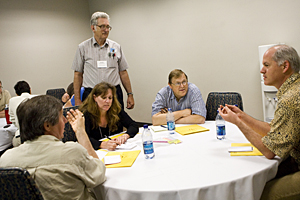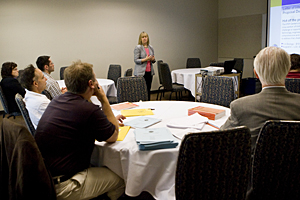

ADVERTISEMENT
- Rozovsky wins prestigious NSF Early Career Award
- UD students meet alumni, experience 'closing bell' at NYSE
- Newark Police seek assistance in identifying suspects in robbery
- Rivlin says bipartisan budget action, stronger budget rules key to reversing debt
- Stink bugs shouldn't pose problem until late summer
- Gao to honor Placido Domingo in Washington performance
- Adopt-A-Highway project keeps Lewes road clean
- WVUD's Radiothon fundraiser runs April 1-10
- W.D. Snodgrass Symposium to honor Pulitzer winner
- New guide helps cancer patients manage symptoms
- UD in the News, March 25, 2011
- For the Record, March 25, 2011
- Public opinion expert discusses world views of U.S. in Global Agenda series
- Congressional delegation, dean laud Center for Community Research and Service program
- Center for Political Communication sets symposium on politics, entertainment
- Students work to raise funds, awareness of domestic violence
- Equestrian team wins regional championship in Western riding
- Markell, Harker stress importance of agriculture to Delaware's economy
- Carol A. Ammon MBA Case Competition winners announced
- Prof presents blood-clotting studies at Gordon Research Conference
- Sexual Assault Awareness Month events, programs announced
- Stay connected with Sea Grant, CEOE e-newsletter
- A message to UD regarding the tragedy in Japan
- More News >>
- March 31-May 14: REP stages Neil Simon's 'The Good Doctor'
- April 2: Newark plans annual 'wine and dine'
- April 5: Expert perspective on U.S. health care
- April 5: Comedian Ace Guillen to visit Scrounge
- April 6, May 4: School of Nursing sponsors research lecture series
- April 6-May 4: Confucius Institute presents Chinese Film Series on Wednesdays
- April 6: IPCC's Pachauri to discuss sustainable development in DENIN Dialogue Series
- April 7: 'WVUDstock' radiothon concert announced
- April 8: English Language Institute presents 'Arts in Translation'
- April 9: Green and Healthy Living Expo planned at The Bob
- April 9: Center for Political Communication to host Onion editor
- April 10: Alumni Easter Egg-stravaganza planned
- April 11: CDS session to focus on visual assistive technologies
- April 12: T.J. Stiles to speak at UDLA annual dinner
- April 15, 16: Annual UD push lawnmower tune-up scheduled
- April 15, 16: Master Players series presents iMusic 4, China Magpie
- April 15, 16: Delaware Symphony, UD chorus to perform Mahler work
- April 18: Former NFL Coach Bill Cowher featured in UD Speaks
- April 21-24: Sesame Street Live brings Elmo and friends to The Bob
- April 30: Save the date for Ag Day 2011 at UD
- April 30: Symposium to consider 'Frontiers at the Chemistry-Biology Interface'
- April 30-May 1: Relay for Life set at Delaware Field House
- May 4: Delaware Membrane Protein Symposium announced
- May 5: Northwestern University's Leon Keer to deliver Kerr lecture
- May 7: Women's volleyball team to host second annual Spring Fling
- Through May 3: SPPA announces speakers for 10th annual lecture series
- Through May 4: Global Agenda sees U.S. through others' eyes; World Bank president to speak
- Through May 4: 'Research on Race, Ethnicity, Culture' topic of series
- Through May 9: Black American Studies announces lecture series
- Through May 11: 'Challenges in Jewish Culture' lecture series announced
- Through May 11: Area Studies research featured in speaker series
- Through June 5: 'Andy Warhol: Behind the Camera' on view in Old College Gallery
- Through July 15: 'Bodyscapes' on view at Mechanical Hall Gallery
- More What's Happening >>
- UD calendar >>
- Middle States evaluation team on campus April 5
- Phipps named HR Liaison of the Quarter
- Senior wins iPad for participating in assessment study
- April 19: Procurement Services schedules information sessions
- UD Bookstore announces spring break hours
- HealthyU Wellness Program encourages employees to 'Step into Spring'
- April 8-29: Faculty roundtable series considers student engagement
- GRE is changing; learn more at April 15 info session
- April 30: UD Evening with Blue Rocks set for employees
- Morris Library to be open 24/7 during final exams
- More Campus FYI >>
9:44 a.m., June 15, 2010----The Howard Hughes Medical Institute (HHMI) Undergraduate Science Education Program at the University of Delaware sponsored the fourth in an annual series of national conferences on undergraduate quantitative biology education from June 9-11 at Clayton Hall.
This and the earlier meetings were held to address an important national concern as voiced in the national study, BIO 2010. This study concluded that in order to be successful undergraduates in the life sciences had to be better trained in the quantitative sciences.
Three institutions -- UD, Emory University and the University of Arizona -- have recently formed a partnership to promote interdisciplinary mathematics and biology education by continuing to offer yearly meetings across the country.
The UD conference was titled “Education on the Edge -- A Conference on Innovative Undergraduate Education at the Interface of Mathematics and Biology.”
Organizers of the meeting were John Pelesko, Gilberto Schleiniger and Tobin Driscoll, all associate professors in the Department of Mathematical Sciences; David Usher, professor in the Department of Biological Sciences; and Hal White, professor in the Department of Chemistry and Biochemistry and director of the UD HHMI program.
The conference attracted more than 60 attendees from across the nation and featured prominent national speakers including Robert Philips from the California Institute of Technology, Louis Gross from the University of Tennessee, Laurie Heyer from Davidson College and Pak-Wing Fok, assistant professor of mathematical sciences from the University of Delaware.
In his talk, Fok described his research showing a mathematical model that can explain the observed rates at which enzymes repair damaged DNA. His model predicted repair rates that were consistent with experimental data. These predicted rates were much faster than previously seemed possible theoretically.
Highlights of the meeting included four workshops on different aspects of education at the interface of mathematics and biology. These were led by Fok, Patricia Marsteller of Emory University, Deborah Allen of the National Science Foundation and on leave from UD's Department of Biological Sciences, Heyer and White.
Fok's workshop dealt with strategies for teaching calculus to students in the life sciences, and Marsteller worked through a problem-based learning activity that incorporated quantitative reasoning in a biological context. Allen led a discussion about various NSF funding opportunities for projects in mathematical biology, and White's workshop with Heyer focused on assessing students' quantitative skills in life science courses.
The advisory board for the Quantitative Biology Program at UD held a panel on education in quantitative biology from the point of view of researchers outside the academy. It led to a lively and informative discussion.
The meeting culminated in a discussion with attendees of what they would like to see offered at future meetings in Arizona, Georgia and Delaware. When UD hosts the conference again in 2014, the new interdisciplinary science and engineering building will be complete, with undergraduate teaching laboratories and adjacent problem-based learning classroom facilities to accommodate innovative interdisciplinary education such as quantitative biology.
In his remarks, George Watson, dean of the UD College of Arts and Sciences, described this building of the future and invited attendees to see the building in action when they return in 2014.
Photos by Ambre Alexander


